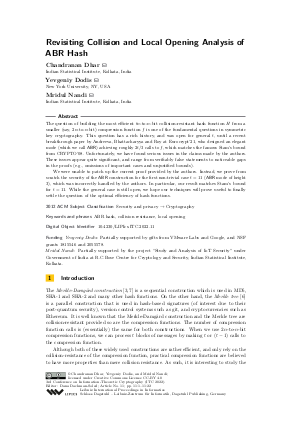Revisiting Collision and Local Opening Analysis of ABR Hash
Authors Chandranan Dhar, Yevgeniy Dodis, Mridul Nandi
-
Part of:
Volume:
3rd Conference on Information-Theoretic Cryptography (ITC 2022)
Part of: Series: Leibniz International Proceedings in Informatics (LIPIcs)
Part of: Conference: Conference on Information-Theoretic Cryptography (ITC) - License:
 Creative Commons Attribution 4.0 International license
Creative Commons Attribution 4.0 International license
- Publication Date: 2022-06-30
File

PDF
LIPIcs.ITC.2022.11.pdf
- Filesize: 0.82 MB
- 22 pages
Document Identifiers
Subject Classification
ACM Subject Classification
- Security and privacy → Cryptography
Keywords
- ABR hash
- collision resistance
- local opening
Metrics
- Access Statistics
-
Total Accesses (updated on a weekly basis)
0Document
0Metadata
Abstract
The question of building the most efficient tn-to-n-bit collision-resistant hash function H from a smaller (say, 2n-to-n-bit) compression function f is one of the fundamental questions in symmetric key cryptography. This question has a rich history, and was open for general t, until a recent breakthrough paper by Andreeva, Bhattacharyya and Roy at Eurocrypt'21, who designed an elegant mode (which we call ABR) achieving roughly 2t/3 calls to f, which matches the famous Stam’s bound from CRYPTO'08. Unfortunately, we have found serious issues in the claims made by the authors. These issues appear quite significant, and range from verifiably false statements to noticeable gaps in the proofs (e.g., omissions of important cases and unjustified bounds). We were unable to patch up the current proof provided by the authors. Instead, we prove from scratch the security of the ABR construction for the first non-trivial case t = 11 (ABR mode of height 3), which was incorrectly handled by the authors. In particular, our result matches Stam’s bound for t = 11. While the general case is still open, we hope our techniques will prove useful to finally settle the question of the optimal efficiency of hash functions.
Cite As Get BibTex
Chandranan Dhar, Yevgeniy Dodis, and Mridul Nandi. Revisiting Collision and Local Opening Analysis of ABR Hash. In 3rd Conference on Information-Theoretic Cryptography (ITC 2022). Leibniz International Proceedings in Informatics (LIPIcs), Volume 230, pp. 11:1-11:22, Schloss Dagstuhl – Leibniz-Zentrum für Informatik (2022)
https://doi.org/10.4230/LIPIcs.ITC.2022.11
BibTex
@InProceedings{dhar_et_al:LIPIcs.ITC.2022.11,
author = {Dhar, Chandranan and Dodis, Yevgeniy and Nandi, Mridul},
title = {{Revisiting Collision and Local Opening Analysis of ABR Hash}},
booktitle = {3rd Conference on Information-Theoretic Cryptography (ITC 2022)},
pages = {11:1--11:22},
series = {Leibniz International Proceedings in Informatics (LIPIcs)},
ISBN = {978-3-95977-238-9},
ISSN = {1868-8969},
year = {2022},
volume = {230},
editor = {Dachman-Soled, Dana},
publisher = {Schloss Dagstuhl -- Leibniz-Zentrum f{\"u}r Informatik},
address = {Dagstuhl, Germany},
URL = {https://drops.dagstuhl.de/entities/document/10.4230/LIPIcs.ITC.2022.11},
URN = {urn:nbn:de:0030-drops-164890},
doi = {10.4230/LIPIcs.ITC.2022.11},
annote = {Keywords: ABR hash, collision resistance, local opening}
}
Author Details
Funding
- Dodis, Yevgeniy: Partially supported by gifts from VMware Labs and Google, and NSF grants 1815546 and 2055578.
- Nandi, Mridul: Partially supported by the project "Study and Analysis of IoT Security" under Government of India at R.C.Bose Centre for Cryptology and Security, Indian Statistical Institute, Kolkata.
References
-
Elena Andreeva, Rishiraj Bhattacharyya, and Arnab Roy. Compactness of hashing modes and efficiency beyond merkle tree. In Advances in Cryptology - EUROCRYPT 2021 - 40th Annual International Conference on the Theory and Applications of Cryptographic Techniques, Zagreb, Croatia, October 17-21, 2021, Proceedings, Part II, pages 92-123. Springer, 2021.

-
John Black, Martin Cochran, and Thomas Shrimpton. On the impossibility of highly-efficient blockcipher-based hash functions. In EUROCRYPT, volume 3494 of Lecture Notes in Computer Science, pages 526-541. Springer, 2005.

-
Ivan Damgård. A design principle for hash functions. In CRYPTO, volume 435 of Lecture Notes in Computer Science, pages 416-427. Springer, 1989.

-
Yevgeniy Dodis, Dmitry Khovratovich, Nicky Mouha, and Mridul Nandi. T5: Hashing five inputs with three compression calls. In 2nd Conference on Information-Theoretic Cryptography, ITC 2021, July 23-26, 2021, Virtual Conference, pages 24:1-24:23. Schloss Dagstuhl - Leibniz-Zentrum für Informatik, 2021.

-
Bart Mennink and Bart Preneel. Efficient parallelizable hashing using small non-compressing primitives. Int. J. Inf. Sec., 15(3):285-300, 2016.

-
Ralph C. Merkle. Protocols for public key cryptosystems. In IEEE Symposium on Security and Privacy, pages 122-134. IEEE Computer Society, 1980.

-
Ralph C. Merkle. One way hash functions and DES. In CRYPTO, volume 435 of Lecture Notes in Computer Science, pages 428-446. Springer, 1989.

-
Phillip Rogaway and John P. Steinberger. Constructing cryptographic hash functions from fixed-key blockciphers. In CRYPTO, volume 5157 of Lecture Notes in Computer Science, pages 433-450. Springer, 2008.

-
Phillip Rogaway and John P. Steinberger. Security/efficiency tradeoffs for permutation-based hashing. In EUROCRYPT, volume 4965 of Lecture Notes in Computer Science, pages 220-236. Springer, 2008.

-
Thomas Shrimpton and Martijn Stam. Building a collision-resistant compression function from non-compressing primitives. In ICALP (2), volume 5126 of Lecture Notes in Computer Science, pages 643-654. Springer, 2008.

-
Martijn Stam. Beyond uniformity: Better security/efficiency tradeoffs for compression functions. In Advances in Cryptology - CRYPTO 2008, 28th Annual International Cryptology Conference, Santa Barbara, CA, USA, August 17-21, 2008. Proceedings, pages 397-412. Springer, 2008.

-
John P. Steinberger. Stam’s collision resistance conjecture. In EUROCRYPT, volume 6110 of Lecture Notes in Computer Science, pages 597-615. Springer, 2010.

-
John P. Steinberger, Xiaoming Sun, and Zhe Yang. Stam’s conjecture and threshold phenomena in collision resistance. In CRYPTO, volume 7417 of Lecture Notes in Computer Science, pages 384-405. Springer, 2012.

-
David A. Wagner. A generalized birthday problem. In CRYPTO, volume 2442 of Lecture Notes in Computer Science, pages 288-303. Springer, 2002.

